News & Events More |
A Cent a Pound or on the Ground: The 1933 Growers' StrikeEven the minimal control the Apple Cartel had provided seemed likely to be absent for the 1933 crop. As late as August 24, the shippers had been unable to come to any agreement on a cartel proposal. But certain vague ideas were already in the air. The same newspaper article which reported the cartel failure also commented editorially that "A movement to leave the apples on the trees might make it interesting for shippers who have made firm sales on Old Country markets." But action, rather than words, was initiated by F.R.E. DeHart of Kelowna. Prices for even the first apples being shipped were slipping dangerously. On about the first of September, DeHart was told of a telegram received in Kelowna which stated that five carloads of apples were sitting unsold at Calgary, unable to find a buyer even at 45 or 50 cents, less than the cost of packing and handling a box. On investigation this report was found to be a hoax, sent by some "interested individual" to force depressed prices even lower. Disturbed and angry, DeHart arranged a meeting on September 4 of growers representing Kelowna and surrounding central Okanagan fruit districts. 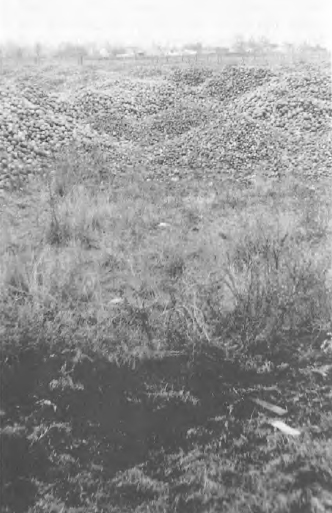
This meeting prepared a resolution for a general mass meeting of growers called for the next day, September 5, in the Empress Theatre: The growers' present position is due to the consignment of fruit to the packing houses: Therefore be it resolved: That the growers organize and refuse to deliver fruit to the packing houses unless the shippers guarantee not to pack or ship such fruit unless it brines a minimum of one cent a pound. More succinct was the fighting slogan coined by J.H. Aberdeen of Winfield: "A Cent a Pound or On the Ground". The mass meeting at Kelowna on September 5 was long and radical, lasting from 10 a.m. to 4:30 p.m. It decided on a two part plan involving a growers' strike for the cost of production and total participation of shippers in a new cartel. The first proposal was outlined by W.E. Haskins, who emerged as leader of the campaign, more as an individual grower than as president of the B.C.F.G.A. He called on growers not to deliver fruit to shippers who would not guarantee forty cents net to the grower for each box they shipped. He realized this might mean some fruit might not be sold, but said that "If apples are to be dumped, . . . let's dump them now before the shippers have any chance to add cost of packing and shipping to be deducted from the returns of those apples that are sold." The second part of the plan, which helped the strike become more than just a vent for indignation, was provided by Robert Cheyne of Glenmore. He amended the original resolution, arguing that the growers must force all shippers into a cartel to control sales. Without a controlled deal it is impossible to get a cent a pound, said R. Cheyne. "How are you going to control 2000 growers? If the shippers refuse to guarantee a price, the growers will weaken and take what they are offered." As the discussion grew heated, W.J. Coe of Winfield stood up and threw a wildly applauded threat at any orchardist who refused to join the growers' strike: If they do not come into the agreement, . . . we will see that they have no apples to ship. I myself will be willing to go and smash his trees. If they put me in jail they will at least keep me, and I am hardly able to do that under present conditions. . . . We need strong-arm stuff now, and not any more kid gloves. Finally, a considerably amended resolution which proposed that growers refuse to pick their fruit unless the shippers formulate a pooled one-desk selling plan and guarantee not to sell fruit at prices returning less than a cent a pound for apples and a cent and a quarter for pears passed by a large majority. Haskins and DeHart were selected as leaders of the campaign. A select committee made up of Haskins, A.K. Foyd of the Belgo, Cheyne, and DeHart was to act as intermediary between growers and shippers. Haskins took on the further responsibility for organizing similar meetings at Vernon and Penticton to present the "cent a pound" campaign. After these moves by the growers, the shippers met at Kelowna on September 6, and the majority decided to join in a new organization, the Okanagan Stabilization Board. This Board was to be managed by Major M.V. McGuire, an independent fruit shipper who had also managed the previous year's Apple Cartel. "The success of the entire plan, however, rests with the growers," declares Major McGuire. "They must lend their fullest co-operation to the scheme, by assisting those shippers who have joined the pool, and by avoiding those firms which remain outside it." 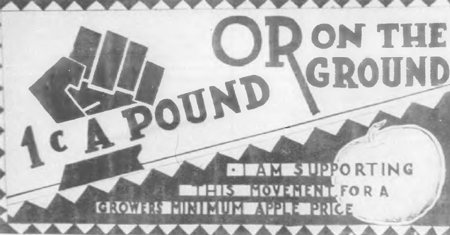
While meetings were being scheduled for other points in the Okanagan and Mainline regions, the temperature of the movement at Kelowna rose. Organized growers, well aware of how many previous marketing schemes had failed because they were unable to control the entire crop, pressed forward with a campaign to sign up all growers in the district and began efforts to stop the flow of fruit to shippers not in the Okanagan Stabilization Board. On September 11, the strike came out in the open with pickets placed on three bridges leading into town from the orchard areas. The pickets stopped all trucks carrying fruit and demanded to see a written statement that the shipper accepted the cent a pound demand. Where this was not forthcoming, the trucks were turned back and unloaded. Efforts were also made to get the cooperation of organized labour, by calling on truckers to decline to haul unguaranteed apples, calling it "scab" fruit. Meanwhile, in what proved the most important step of the campaign, an agreement was signed on September 11 between the Kelowna growers' committee and the Okanagan Stabilization Board. This agreement, contingent upon one hundred per cent stabilization, set up a pricesetting and control committee with three members from the Stabilization Board and three from the growers, with Major McGuire as chairman. This agreement set prices at a cent a pound to the growers. Shippers were to make partial payments within a month after sale. For its part, the growers' committee agreed to urge all growers to refuse to deliver fruit to any shipper not a member of the Stabilization Board. This was a significant development, for now the urgency shifted from enlisting growers to signing up shippers for the Stabilization Board. Refusal by a few growers to join did not matter if their shippers were themselves in the agreement. The greatest resistance was met at Kelowna, where several shippers and grower-shippers at first refused to sign. But on September 12, Okanagan Fruit Shippers Ltd., the Occidental Fruit Company, and Rowcliffe Brothers were induced to sign, and the following day the last holdout, Joseph Casorso of the Belgo Co-operative Growers' Association, was also persuaded, by means of what was later termed illegal intimidation.’ Finally all fifty-two shippers in the Okanagan were part of the Okanagan Stabilization Board. Two rulings of the joint committee were to cause trouble. The first was a levy on fruit shipped. This levy, intended to equalize pools, was eventually the downfall of the Board. The second was a ban on shipments of orchard-run bulk (unsorted and loose packed) McIntosh to Prairie markets. Some shippers, particularly the smaller ones, were very much upset by this ruling, as it meant they would have to make much greater cash investments in sorting and packing. The first challenge came almost immediately, on September 20, from Joe Casorso of the Belgo Co-operative. A "flying squad" of two hundred growers, led by R.F. Borrett, descended on two packing houses and found boxcars being loaded with bulk McIntosh. They threatened to dump the carloads, but finally were satisfied with sealing them and preventing shipment. For the moment Casorso, who had been "out of town", toed the line. The next day the cars were unloaded and the apples graded and packed, but Casorso was a stubborn man who did not give in easily. A week later, on September 28, he made his second challenge, together with the Rowcliffe brothers of Hollywood Orchards. They started loading two cars of bulk Macs, later increasing the number to seven. When news of this came to Haskins, he called a mass rally of local growers, at which he spoke of non-violence, but said that shipment of those cars must be prevented at all costs. "Gandhi-like passive resistance has been very successful in India, Mr. Haskins added, and urged all present to go down to the tracks." The belligerent crowd surrounded the packing houses, where loading was still going on, and despite the presence of five policemen, stopped the loading by throwing stones and cutting the power lines to the buildings. At about 11:30 p.m. the freight engine came from the yards to make up the train. The crowd of four hundred fruit growers and their wives and children stood between the boxcars and the locomotive. They defied the engineer to try to link up with those cars, shouting, "Only over our dead and mutilated bodies will those cars move out on the tracks". The train crew, however, was quite willing to back down, and went away to deal with undisputed freight. To see that the boxcars stayed put, the crowd stayed, grouped around bonfires and singing, until 2:30 in the morning. News then came from Vernon that their legal representative, T.G. Norris, had obtained an injunction against the Rowcliffes and the Casorsos, restraining them and their agents from disposing of fruit except as the terms of the agreement required. After this news reached the growers' headquarters in Kelowna, "a motor car swept down the Kelowna streets, horn blaring, to proclaim the victory." Before the hearing on the injunctions, scheduled for October 7 at Kamloops before Judge Swanson, the rebels backed down and agreed to abide by the regulations of the Stabilization Board. 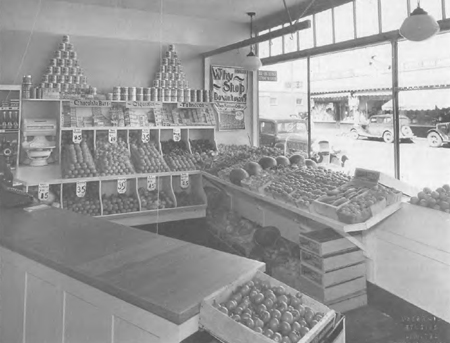
The major opponents of the stabilization campaign had been dealt with, but constant vigilance was kept. The final open challenge came at Vernon on October 20. D.W. Henry, a Coldstream grower who until then had sold his fruit through a local shipper, decided to ship it himself. Not having been a shipper when the Stabilization Board was formed, he had not signed the contract. Through J.R Delf of Calgary, who had just set up a brokerage house in Vernon, Henry sold several carloads of apples at prices well below the Stabilization Board minimum. Three cars had already left the Valley, and another three were being loaded, when another "flying squad" of a hundred growers arrived. The grower was dissuaded from his course of action by pressure of "moral obligation", and the broker's bags were packed for him and delivered to the train station. 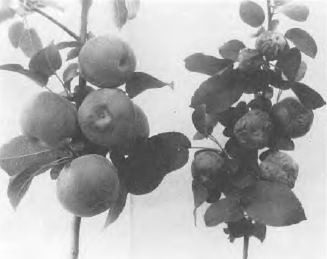
The activities of W.E. Haskins and the Growers' Stabilization Committee continued, however, as they sought to maintain grower support for the campaign, to make plans for permanent grower geographical extent of stabilization. Haskins toured the Kootenays in December calling on fruit growers there to join the organization. And then, "Bearing the banner of the Big Red Apple, inscribed with the mystic words 'Grower Control- Minimum Price', with the war slogan, 'A Cent a Pound or on the Ground', lettered faintly in the background," he led a campaign through the Okanagan and Mainline areas in support of a grower controlled "New Plan" of central selling. In this atmosphere of fervour, W.E. Haskins was an eminently suitable leader. The Vemon News described him as "better known as a cheer leader and for his ability to sway people at meetings than as an administrator. He is a master politician and in his thinking is generally about three jumps ahead." Haskins himself is reported to have complained that when he spoke about marketing systems and economics no one paid much attention, but when he attacked the Water Street jobbers, growers would stand up and cheer. 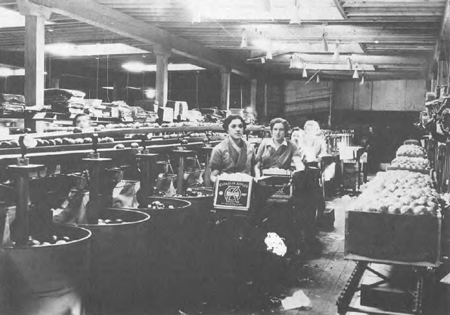
Haskins, and the campaign he led, were not identified in the growers' minds with either camp in the cooperative-independent feud. Although he was president of the B.C.F.G.A., the cent a pound campaign arose entirely separately from that organization, and the Growers' Stabilization Committee voted against any takeover by the B.C.F.G.A. At this point, the B.C.F.G.A. was on such uncertain ground that it asked the Stabilization Committee, which had funds from grower levies, for a loan to tide it over until the year end. As a spontaneous growth out of indignation meetings, the campaign was the child of neither Associated Growers nor of the independent shippers. Indeed, in its early stages, it was criticized by both the president and vice-president of Associated Growers, as well as by the various stubborn independents. It was truly a growers' rather than a shippers' movement. Government, surprisingly, also had little to do with the 1933 stabilization campaign, despite the unusual and unlawful behavior of the aroused growers. The federal authorities washed their hands of the matter, saying that administration of the law was a provincial responsibility. The provincial government was in no shape to do anything, for the ruling Conservative Party was disintegrating and an election had been called. No politician was willing to risk the displeasure of so large a portion of his electorate, particularly after the mass meeting at Vernon passed a resolution calling for growers to pledge themselves not to vote for any candidate who was not committed to pressing for legislation along the lines of the British Marketing Act. The Okanagan growers' campaign established complete control of the apple supply in the Valley for the Okanagan Stabilization Board. All the Board had to do was to sell the crop, but the possibility quickly arose that it might not be able to do so without abandoning the price guarantee. Sales were very sluggish in the early part of the season for three reasons. The first was the new price scale which, combined with the cessation of cheaper bulk shipments and increased freight rates, made for an overall fifty per cent rise in the consumer price of McIntosh apples to Prairie residents. The second factor slowing sales was the Prairie jobbers. Most expressed sympathy for the growers' cause, but a few were openly hostile and attempted to undermine the Stabilization Board's stand and induce it to lower prices. The third problem was that even the sympathetic jobbers were, for business reasons, likelier to buy their apples from the Kootenay, Creston, and Grand Forks areas, which for lack of time had not been brought into the whirlwind crusade for stabilization. These areas were selling apples at about fifteen cents a box less than the Okanagan set price. Not until mid-December, when the four hundred carloads of Kootenay apples had been sold, could the Okanagan fruit start moving freely onto the Prairies. One result was an overly heavy export to England and thus low prices. But eventually all the apples were sold, and no dumping was required. The overall average f.o.b. price for packed apples from the 1933 Okanagan crop was $1.00 per box, returning more than the called-for minimum of forty cents a box to the growers. The downfall of the Okanagan Stabilization Board came with the trial of the case of McGuire vs. Crestland Fruit Company. Major McGuire, as pool agent of the Stabilization Board, sued that company (which had been set up the previous year by a Prairie jobber to get an entry into the Okanagan) for $10,157 of equalization levies which it refused to pay. The refusal seemed the more grievous in that Harvey Harrison, manager of the Crestland Fruit Company, had participated in the formation of the Stabilization Board and had himself introduced the motion to impose the very levy he later refused to pay. Vignette: Little Cherry DiseaseIn 1920 two-thirds of the cherry trees in British Columbia were in the Kootenay-Arrow Lakes region, but by 1955 the number had fallen to slightly more than two per cent of the provincial total. How did the Kootenay cherry industry disappear? The culprit was the devastating Little Cherry Disease, which first appeared in British Columbia in 1933 in the orchard of a Mr. Heddle at Willow Point, near Nelson.2 While the trees themselves are not harmed (indeed, some of the originally infected trees at Willow Point still survive in a completely neglected state), fruit on diseased trees never develops fully; at picking time the cherries are insipid and lacking in sweetness, only half to two-thirds of normal size, dull red, and angular with three flattened sides. Little Cherry Disease spread slowly at first, but soon picked up speed. In 1934, diseased trees were found in three orchards neighbouring the original outbreak, and by 1940 the infection had spread to an area twenty miles in diameter. By 1947, all the fruit areas of the Kootenays, except Deer Park-Renata and Needles-Edgewood on the Arrow Lakes, had shown cases of the disease. It spread rapidly, ignoring the natural barriers of lakes, mountains, and the considerable distances between orchards, leaping gaps as large as thirty miles.3 The plantings in the unaffected areas on the Arrow Lakes remained immune for some years, but these areas were flooded when the High Arrow Dam was built. At first the cause of the disease was unknown, but in 1940 W.R. Foster, Assistant Plant Pathologist with the B.C. Department of Agriculture, started to study the disease and the following year he determined that a virus was at fault. Research, directed towards finding either a cure or a resistant cherry strain, continued as the disease spread through the Kootenays; in 1946, the federal Department of Agriculture established a sublaboratory at Creston.4 In the same year the movement of fresh cherries and nursery stock from the Kootenays to the Okanagan was prohibited in order to prevent the spread of the disease. When it was determined that the original Willow Point infection had almost certainly come from a Japanese flowering cherry tree, and that almost all ornamental flowering cherries are infected with the virus, the provincial government ordered all such trees removed and banned the sale or planting of them within the protected area. 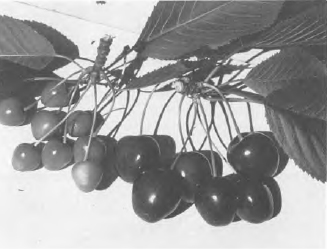
Helped by the quarantine measures, and further protected by the fact that the wild bitter cherry, which is also susceptible to the virus, does not occur in the Okanagan south of Squally Point,6 the Okanagan remained free of Little Cherry for nearly forty years. But in 1969, an orchard at Penticton was discovered to be infected when the grower asked his local horticulturist what to do about the small size of his cherries. That outbreak was contained, but in 1973, a much more serious situation appeared with the discovery of infected trees in Penticton, Naramata, and Kelowna. In following years Little Cherry Disease was found in scattered locations throughout the Okanagan. By 1977, over 1400 trees had been removed.' With the danger of an explosion of Little Cherry Disease in the Okanagan similar to that which devastated the Kootenays, vigorous efforts have been made to prevent its spread. Orchards are surveyed yearly to find and eradicate affected trees. The provincial government and the B.C.F.G.A. sponsor a program to compensate for removal of trees adjacent to those affected, which might be infected but not yet showing symptoms of the disease. And spray programs to reduce populations of apple mealybug, suspected of being a transmitter of the virus, have prevented Little Cherry Disease from becoming firmly established in the Okanagan. But the latent danger remains and growers must maintain vigilance. Justice Denis Murphy of the Supreme Court of British Columbia ruled against McGuire and the Board on March 15, 1934, saying that the agreements, made under intimidation and duress, were illegal and unenforcable as being in restraint of trade and contravening the Criminal Code. Thus the cloud of illegality, which had hung over proceedings from the start of the campaign, finally rained. 
Haskins and his Growers' Stabilization Committee fought on, refusing to admit defeat, and put forward a new plan for total grower control of marketing through the "United Fruit Producers' Association of B.C.", headed by Haskins, George Barrat of Kelowna, and O.W. Hembling of Oyama. But most growers looked for solutions to the marketing legislation promised by the federal government. The Growers' Strike vividly demonstrated the despair of orchardists in 1933. They abandoned their previously predominant policies of cooperation and legislated control-and their traditional organization, the B.C.F.G.A.-in favour of an extreme plan of direct action. They now stepped back from that radicalism, but they had established in their own minds and in those around them that, in future, growers rather than shippers should be the ones who made the decisions. Contact Us Hours: 9am - 4pm weekdays. t: 250-762-5226 |

